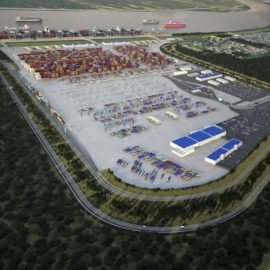
Harking back to Katrina, the marsh construction in St Bernard was showcased.
The cross rising from the water at the end of the road in Shell Beach stands as a poignant memorial for Hurricane Katrina’s victims – and state officials say Louisiana’s biggest marsh creation project under construction behind it will help limit such tragedies in the future. “I think one of the greatest lessons that we’ve learned over the last few decades is that natural buffer is just as important as your hurricane risk reduction system,” Chip Kline, chair of the state’s Coastal Protection and Restoration Authority, said of the vast network of levees and floodwalls built since the 2005 storm. “This natural buffer – our marshes, our wetlands – are helping protect us.” Kline and others were at Shell Beach in St. Bernard Parish on Friday to see progress on the $115 million project and discuss others also underway as part of the state’s 50-year, $50 billion master plan for saving as much of the disappearing coast as possible.
nola.com
The State needs to approve so this is an effort to garner support.
The visit came at an important time for those plans. The coastal protection authority recently released drafts of its $1.74 billion annual plan and its new five-decade master plan, which is updated every six years. After a public comment period, the authority will be seeking approval of both proposals from the state legislature in the months ahead. Gov. John Bel Edwards, now in his final year in office, was due to join the visit, but canceled due to the death of his mother. The visit included an airboat ride that provided state and parish officials with an up-close view of the work so far, taking them to the eroded marsh between the Mississippi River-Gulf Outlet, or MRGO, and Lake Borgne. It’s a spot well-known to many southeast Louisiana fishers, and those old enough to remember can attest to its dramatic changes over the years, with saltwater intrusion, erosion and subsidence steadily eating away at what used to be land. Much of the erosion in the Shell Beach area can be attributed to the MRGO, which fully opened in 1968 as a shipping shortcut from the Gulf to New Orleans’ doorstep. The channel was also labeled a “hurricane highway” after Katrina, blamed for helping speed storm surge toward New Orleans. It was closed in 2009 with construction of a rock dam near Shell Beach.
Construction started a year ago and will be completed in 2025.
Construction on the Lake Borgne Marsh Creation project began about a year ago and is due to wrap up in August 2025. It will be financed with settlement money related to the 2010 BP oil spill, though a separate plan to restore wider wetlands MRGO has degraded will be paid for by the federal government. The marsh project will use around 13 million cubic yards of dredged soil, or enough to fill more than five million pickup trucks. Around 2,800 acres of marsh will be created. Like other such projects, it will have an expected lifespan of 20-30 years. During Friday’s tour, giraffe-like yellow excavators worked to build mud berms that will hold in the sediment. St. Bernard President Guy McInnis lauded the project and others in the parish at a press conference that followed the tour. “It’s all for the resilience of our community, and to keep our culture and our heritage for future generations,” he said.
There are mixed feelings but the construction of the marsh may impact fishing.
Robbie Campo, whose family’s Campo’s Marina at Shell Beach has existed for 120 years, said that while he’s concerned that separate river diversion plans for the future will drastically change the area’s fishing environment, he’s relieved to see new marsh being constructed. “If we don’t do something over here, the lake is going to be into the MRGO,” said Campo, 54, who has watched the wetlands slowly erode over his lifetime spent along the water. “We’re going to lose it all.”
I take marsh over fishing.



